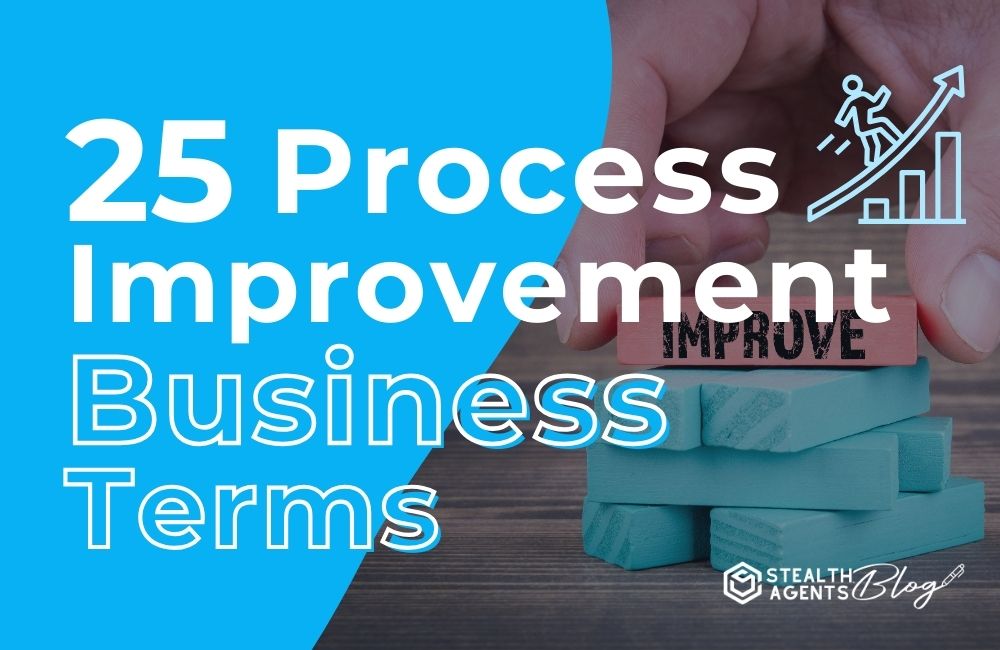25 Process Improvement Business Terms
Your business is a living organism with a myriad of processes intertwining like cell structures, each one influencing the overall growth and health. But what if I told you there’s an entire lexicon designed to trim the fat, enhance productivity, and ultimately drive success? In this article, we’ll embark on a journey through 25 vital process improvement terms that every growth-focused leader should engrave into their business playbook.
Step in with an open mind, ready to absorb strategies from a virtual pantheon of process gurus, and let’s transform your enterprise with the lexicon of efficiency!
Continuous Improvement
At the heart of any successful business, you’ll find teams that constantly strive for betterment. Continuous improvement is no longer a buzzword but a way of life, with mechanisms and tools geared towards incremental enhancements, ensuring that your operations remain agile, adaptive, and always gear towards perfection.
Lean Six Sigma
Imagine the synthesis of two powerhouses – Lean methodology (streamlining operations and improving efficiencies) and Six Sigma (minimizing defects and variability). This dynamic duo ushers in an era of precision, where every aspect of your business process is under the microscope for improvement.
Kaizen
Originating from Japan, Kaizen reflects a culture of ‘always improving’, not just in the professional space but also in our personal lives. It’s a powerful mindset that advocates for small, daily changes that lead to staggering improvements over time.
Value Stream Mapping
An essential tool in understanding and optimizing your workflows, Value Stream Mapping helps you visualize the steps from product creation to delivering it to the customer. It’s here where you eliminate non-value adding stages and ensure that each remaining step is refined to deliver maximum value.
Root Cause Analysis
To solve a problem, you must dig deep and address its source. Root Cause Analysis is a technique to identify the primary reason behind an issue, ensuring that corrective actions are focused and eliminate the possibility of the same problem rearing its head in the future.
Pareto Principle
The 80/20 rule is more than just a philosophical concept – it’s a powerful principle in process management. By understanding that 20% of inputs lead to 80% of outputs, you can focus your efforts on the critical elements that push your business forward.
Fishbone Diagram
In the art of problem-solving, the Fishbone Diagram, or Ishikawa diagram, is a method that encourages you to think about all potential causes of a problem. It takes a holistic view, ensuring that no stone is left unturned in your pursuit of efficiency.
5 Whys
Sometimes, the simplest questions lead to the most profound insights. The 5 Whys technique obliges you to question the nature of a problem, peeling back the layers until the root cause is revealed. No ornate tools or complex strategies – just five honest ‘whys’.
DMAIC
An acronym synonymous with the Six Sigma methodology, DMAIC represents a structured approach to improving your business processes: Define, Measure, Analyze, Improve, and Control. Each phase is a critical step towards achieving and maintaining the highest quality.
PDCA
Plan, Do, Check, Act – a cycle that perpetually feeds into itself. Plan a change in your business process, carry it out, analyze the results, and act to standardize or improve. This never-ending loop is the soul of agility and the bane of stagnation.
Standardization
To achieve consistency and repeatability, standardization is key. It ensures that processes are clear and everyone is on the same page. It’s the cornerstone of a reliable and efficient operation.
Error-Proofing
Human errors can be costly and, in some cases, catastrophic. Error-proofing, or Poka-Yoke, introduces mechanisms that prevent mistakes before they happen, whether through foolproof designs or process controls.
Kanban
Originally a scheduling system for lean manufacturing, Kanban is now a popular tool for visualizing workflow, limiting work in progress, and maximizing efficiency. It’s simple, visual, and incredibly effective at keeping your processes flowing smoothly.
Just-in-Time (JIT)
The JIT philosophy aims to minimize inventory and produce just what’s needed, when it’s needed, and in the amount needed. This lean principle is a boon for minimizing waste and reducing overproduction.
Bottleneck
A bottleneck is a stage in your process where the work is slowing down your entire workflow. Identifying and addressing these points of constriction is vital to increasing overall efficiency.
Cycle Time
In the realm of processes, how long a task takes is crucial. Cycle Time analysis allows you to establish the average time it takes to complete one round of a process, a critical metric when evaluating improvements.
*advertisement*
Tired & Overwhelmed With Administrative Tasks?
Hire A Top 1% Virtual Assistant From Stealth Agents!

Sign Up Below & Hire A Top 1% Virtual Assistant
Rated 4.7 Stars Serving Over 2,000+ Customers.
Hire Top 1% Virtual Assistants For $10-$15 Per Hour
Ask About Our 14 Day Trial!
*advertisement*
Lead Time
Measured from when a customer places an order to when they receive it, Lead Time is a pivotal metric for customer satisfaction. Shorter lead times usually mean more agility and responsiveness.
Takt Time
Takt Time is the heartbeat of your production process, the pace at which you need to produce to meet customer demand. This metric ensures a harmonized and balanced workflow.
Poka-Yoke
Mistake-proofing is the essence of Poka-Yoke. By implementing simple, yet effective safeguards and checks, you can reduce human error and increase the fortitude of your processes.
Gemba
There’s no substitute for seeing the actual point of action. In Japanese, ‘Gemba’ means the ‘real place’. To understand a process fully, it’s essential to go to the ‘gemba’ and observe operations firsthand.
Andon
In the world of lean manufacturing, ‘Andon’ is a visual management tool that highlights problems. By stopping the line when an issue arises, you can fix it then and there, preventing further waste.
5S Methodology
Sort, Set in order, Shine, Standardize, and Sustain – The 5S Methodology is a framework for organizing a workspace for efficiency, effectiveness, and safety. A tidy house not only brings peace of mind but also streamlined processes.
Visual Management
Humans process visual information much faster than text. Visual Management uses graphs, charts, and other displays to convey information immediately, a key tool in maintaining a well-oiled machine.
Total Quality Management (TQM)
A holistic approach to quality management that encompasses every employee and every department, TQM ensures that the customer is at the center of every process, guaranteeing a focus on continuous improvement.
Key Performance Indicators (KPIs)
Without measurement, there can be no improvement. KPIs are your lighthouse, guiding you towards better performance. They measure the success of a process against the goals of your organization, ensuring you stay on track.
Conclusion
Incorporating these 25 process improvement terms into your business vocabulary is akin to learning a new language – a language of efficiency, reliability, and ultimate success. As you digest these concepts and apply them to your daily practices, watch how the very fabric of your business transforms into a lean, mean, productive machine.
Remember, it’s the small changes, compounded over time, that lead to the big wins. So, here’s to your business’s evolution – one optimized process at a time.









